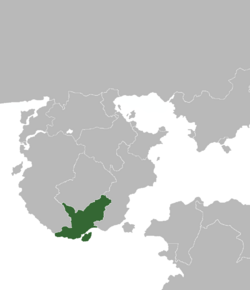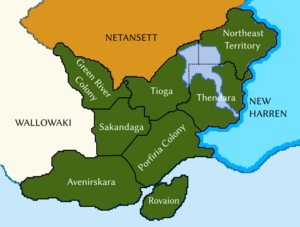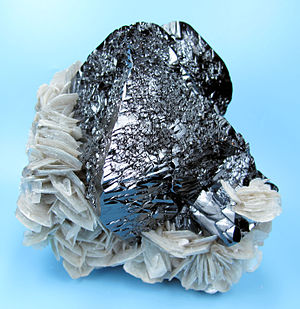Porfíria
This page is currently undergoing major reconstruction in accordance with broader lore changes. |
Porfíria (Kiravian Cusinaut) | |
|---|---|
 | |
| Major cities | Érskinsar, Krivôrok, Vittēmur |
| Languages | Kiravic Coscivian, Mannaki, Burgoignesc, Kilikas-Valēkas Coscivian, Eshavian Coscivian, Ĥeiran Coscivian |
| Type | Overseas Region |
| Provinces | |
| Population | |
• Estimate | 14,148,046 |
| Time zone | West Cronan Offset Time |
Porfíria or Kiravian Cusinaut is an overseas region of the Kiravian Federacy located on the southern extreme of the Cusinaut subcontinent in northeastern Crona. The territory extends from the island of Rovaīon into the Archangel River Valley, bordering New Harren to the east and including the Kiravian colonies of Avenirskara in the southwest and Térrurin to the northwest. Porfíria was first permanently settled by Kiravians in 1618 AD, when the fort and trading post of Vittēmur was established at the mouth of the Archangel River. The colony subsequently attracted many thousands of Kiravian settlers who built a local economy based on exploitation of its abundant natural resources.
History
Pre-Colonial
The history of Porfiria stretches back to ancient times when the land was inhabited by various indigenous nations, including the Mannaki people who thrived in harmony with nature. The Sharkota, another indigenous group, also inhabited the region, and both nations developed vibrant cultures and trade networks.
Colonisation
During the colonial era, Porfíria witnessed a flurry of Kiravian and Yonderian settlement along its coastlines. Kiravian and Yonderian explorers, driven by aspirations of wealth and power, established trading outposts and fortified settlements to solidify their presence in the region. These early colonies became centers of commerce, attracting merchants and craftsmen. As Kiravian and Yonderian settlements expanded, tensions between the two powers grew, and Burgundie - already locked into global colonial competition with Kiravia - was drawn in on the side of the Yonderians. Their competition for control over strategic resources and trading routes led to numerous clashes and conflicts. The struggle for dominance played out both on land and at sea, with naval battles becoming a common occurrence along Porfíria's shores. This period witnessed a series of fortified defenses being constructed to protect the interests of the Kiravians and the Yonderians and Burgittans. Forts, bastions, and batteries dotted the shoreline, acting as visible symbols of colonial power and control. Some of these fortifications still stand today, serving as reminders of Porfíria's tumultuous past. This conflict culminated in the War of the Broken Biscuit, which ended with Kiravian forces led by Adm. Hesperius Leonoix overwhelming the Yondro-Burgittan defences, forcing the cession of the Porfírian coast and Seváronsa to the Marble Emperor under the Treaty of Ampeloniki. The terms of the treaty obliged the Kiravian administration to respect the rights of the Cusinautiens (as the Yonderian colonists were called) and allow them to remain unmolested.
Upriver expansion of Kiravian settlement was undertaken mainly by Ensciryan Coscivians and Northern Coscivians drawn by promises of landownership and new opportunities. These intrepid pioneers established communities and brought with them their rich traditions. Over time, the Ensciryans intermarried with the indigenous populations, forming unique cultural expressions and building prosperous towns and villages.
[Conflict and coëxistence with the natives]
Porfíria was originally governed from Érskinsar on the nearby island of Rovaīon. The Corned Beef Excise Dispute of 1672 moved colonists living in the mainland settlements to agitate for a separate legislature, which was granted by the Porfíria Act of 1674, though Rovaīon and the mainland settlements continued to share a high court and a governor. Rovaīon was separated from Porfíria and granted its own charter in 1680, and separate governors were appointed from 1683 onward. Ethnic differences between the majority Eshavian settler population of Rovaīon, and that of the mainland settlements (a more heterogeneous mix of Ensciryans, North Coscivians, Kir, Eshavians, and Gaels) also contributed to the demand for bifurcation. Avenirskara would later be spun off as its own colony, as would the Green River Colony and the Northeast Territory in order to provide closer supervision of these sensitive frontier regions.
Economy
The colonial economy of Porfíria relied on four sectors: Maritime trade and fishing in the coastal regions; timber, shipbuilding and naval stores; agriculture, and (to a lesser extent in the colony's early stages) mining. The region's abundant coastal waters teemed with fish, providing a valuable resource for sustenance and trade. Both the Kiravians and Yonderians recognised the economic potential of these fisheries and established fishing outposts along the coastline. The fishing industry flourished, with salted and dried fish becoming a sought-after commodity in Crona and Alshar. This thriving trade network not only brought wealth to the colonies but also facilitated cultural exchange and interaction with international markets.
Agriculture played a significant role in the colonial economy of Porfíria, and employed a plurality of Porfírian workers. The soil and climatic conditions of southern Cusinaut were not ideal for agriculture in general, but were sufficiently favourable to the cultivation of Kiravian staples by farmers from the Highlands and upper latitudes with experience farming in a similar environment to enable the emergence of a viable agricultural sector. The Ensciryans, with their agricultural expertise, introduced new farming techniques and crops to the region, cultivating potato, Coscivian cuckwheat, dralm, oats, and gourds. Stock raising of sheep, dairy cattle, and swine was also a major source of value. Surplus produce was traded mainly to other colonies with lower agricultural output, such as Thýstara, and as provisions to visiting ships. The agricultural sector not only provided sustenance for the growing population but also contributed to the economic growth and social stability.
Northern Tracts and the Law of Settlement
By 1704, the legal boundary of Porfíria had extended far northward into the Cusinaut interior to the border with the Northern Confederation; this land had been acquired by intermittent warfare and treaties between the colonial settlers and native peoples. This area, known as the "Northern Tracts", was largely unsettled and is roughly coterminous with modern Netansett. In colonial Cusinaut, such land claims were not effective sovereignty, but rather the right to obtain and settle indigenous lands to the exclusion of other colonial powers. Increasingly, however, border forts, trade posts, and other zones of control began to be erected by the Kiravian colonial administrators through the early-to-mid 1700s. Kiravia was able to project power in this region despite limited resources because of the fractured nature of the local tribal people, who were deeply divided by ancient political and social differences. The rising power of Kiravia led to a reconsideration of these animosities, and in 1764 the landmark Treaty of Hukon was signed by the eight most powerful tribes in the region. The Treaty bound them together in loose confederation and military alliance. From then on, the Hukon League launched ever-larger raids into southern Porfíria, devestating the economy and disrupting settlement efforts. The "Hukon War" ended in 1773 with the Treaty of Vittēmur. The Treaty pledged to prevent further settlement in the Northern Tracts but allowed existing trading posts and forts to remain, and also required the Hukon to continue to trade exclusively with Kiravia rather than with other Occidental powers or the Northern Confederation. The Treaty effectively recognized the Hukon League as the legitimate representative body of indigienous peoples in the Northern Tracts. Per the Treaty, in 1774 the new Law of Settlement was enacted, which forbid non-native peoples from settling north of a certain line within Porfíria. The Settlement line comprises Porfíria's modern northern boundary.
Sunderance
During the Sunderance, Porfíria and the rest of Kiravian Cusinaut remained loyal to the Federalist government of Séan Kæśek, forming the largest contiguous area of the Kiravian Remnant and the second most populous (after Æonara). Porfíria's resources and manpower were crucial to keeping the Remnant's economy afloat during its early stage.
Post-Restoration
Kiravian Reunification brought hard economic times on Porfíria and its neighbouring colonies, as they now had to compete with Great Kirav and Koskenkorva as domestic suppliers of many of the same commodities. The post-reunification economic struggle of Porfíria and similarly-situated colonies - called the 'Little Reädjustment', in contrast to the 'Great Reädjustment' on the Kiravian mainland - was the main impetus behind the formation of the Overseas Development Executive.
Despite pessimistic forecasts by some economists, who claimed that Porfíria would never financially recover from this, Porfíria financially recovered from this.
During the Deluge, Porfíria was directly involved in the Kiroquois War. It hosted numerous Kiravian military support activities during the Final War of the Deluge, and also introduced limited conscription into its provincial self-defence and civil defence forces due to fears of home-soil attacks launched from Varshan and Netansett, the first new instance of conscription in the Kiravian Federacy since the 1988 AD National Service Suspension Order.
Geography

Most of Porfíria has an oceanic climate.

Major Settlements:
- Érskinsar, Rovaion
- Krivôrok, Thendara
- Vittēmur, Porfíria Colony
- Inverporfír, Porfíria Colony
- Parera, Avenirskara
- Nantuxen, Green River Colony
- Kaśiska, Tioga Colony
- Saar-Macféden, Northeast Territory
- Vómrasar, Avenirskara
- Sudhrun, Porfíria Colony
- Krummavísur, Northeast Territory
Economy



Although not as highly developed as its offshore neighbour Rovaīon, Porfíria has a growing and diversifying economy based on a strong primary sector - including agriculture, mining, and the harvesting of timber and fish - and supplemented by transportation, resource processing, and service industries.
During the Sunderance, Porfíria experienced a manufacturing boom. The loss of the Kiravian Mainland forced the relocation of many strategic heavy industrial works, and Porfíria, with its abundance of raw materials, would become the destination for many. Industrial growth was most heavily concentrated in Krivôrok, where Tredagon Arms Factory opened a large munitions plant. Many such factories shut down in the decades following Kiravian Reunification, but some have remained, albeit with considerably reduced workforces.
The climate and terrain of Porfíria are quite similar to that of Great Kirav, and colonists have had great success cultivating Kiravian staple crops such as potato, cale, barley, and oats. Crops native to Cusinaut, such as sallaw and clubfruit, are also cultivated, both by the indigenous population and on settler-owned land. Livestock raising is an important activity, focused on sheep and guanacos introduced from Great Kirav. As a result of the distributist land tenure policies adopted during colonisation and their continuation in the colony's own property laws, most settler-held agricultural land is family-owned and organised into parcels ranging from medium-sized estates to small, single-family homesteads. Most native-held agricultural land is owned collectively, either by tribes and clans according to traditional customary law or by the governments of the autonomous Mannakidan territories. Forestry is also an important industry, and Porfíria is a rising producer of softwood timber, pine resins, and paper products.
Rich stocks of [types of fish] and shellfish such as [species] are found in the cold waters of the Northern Approaches and the wider North Levantine Ocean, and [species] is plentiful in the relatively unpolluted Archangel River.
Tourism is hoped to become a major source of income for the colony in the future, as Porfíria's breathtaking natural scenery, agreeable (for Kiravians) climate, and many opportunities for hunting and fishing promise to make it a prime destination for the popular Kiravian activities of skiīng and backlanding.
Politics and Governance
As a chartered territory, Porfíria is an integral part of the Kiravian Federacy for the purpose of constitutional law, and enjoys a level of self-governance more limited than that of a full state but greater than that of a dependency or federal district.
The highest executive authority in the territorial government is the Executive Council, which is chaired by the Governor and comprises 10-15 additional members. Most members of the Executive Council are appointed by the Governor, but two are elected by the citizenry, another two are elected by the Legislative Conference, and one is chosen from among the indigenous leaders of the territory. The Governor himself is appointed by the Prime Executive of the Kiravian Federacy. The Executive Council directs the colony's bureaucratic apparatus and government agencies, managing them on a day-to-day basis as well as charting short- and medium-term policy directions. Executive decisions are usually made collectively, but certain powers, such as commanding the territorial militia and declaring states of emergency, are exercised unilaterally by the Governor, and the Governor's signature is required to validate all executive orders originating from the Council.
The colonial legislature, the Legislative Conference, comprises 50 members elected by single transferable vote. It is non-partisan, as political parties are banned by Porfíria's territorial charter. The Legislative Conference has the power to pass statutes, levy territorial taxes, elect two members of the Executive Council, confirm judicial appointments made by the Governor, and rule on certain matters concerning real property by means of private bills.
The prevailing political sentiment in Porfíria can be described as broadly conservative with a libertarian streak, owing to the colony's history as a frontier province. Porfírians remained steadfastly loyal to the Kiravian Remnant during the Sunderance. However, agrarian populism and a moderate socialist movement emanating from trade unionism in and around the mining sector are also important in Porfírian politics, whereïn the latter is represented by the SDKF.
| Member | Party | First Elected | |
|---|---|---|---|
| Svíridur Vidhedran | Renaissance Party (FRA) | 21206 | |
| Angus MacKeldin | Independent (FRA) | 21206 | |
| Ensor Stóltesar | Social Democrats KF | 21206 | |
Law
Most of Porfíria does not have a seatbelt law in effect. Such a law is in effect on Rovaīon.
Society and Culture
[Statistical Demography]
Ethno-cultural Groups
- Coscivians: Kir, Ensciryan Coscivians, Northern/Kilikas-Valēkas Coscivians
- Cusinautiens (from Yonderre)
- Natives: Mannaki, Sharkota, others?
- Kiravian and foreign Gaels
Religion
Sports
Lacrosse is the most popular sport in Porfíria. The most popular professional sports league in Porfíria is the Northern Crona Lacrosse Association (NCLA), a league with fourteen teams across Porfíria and New Harren.
Porfíria and New Harren also share a professional soccer league, the sixteen team Cusinaut Football Associated League (CFAL).
See also
